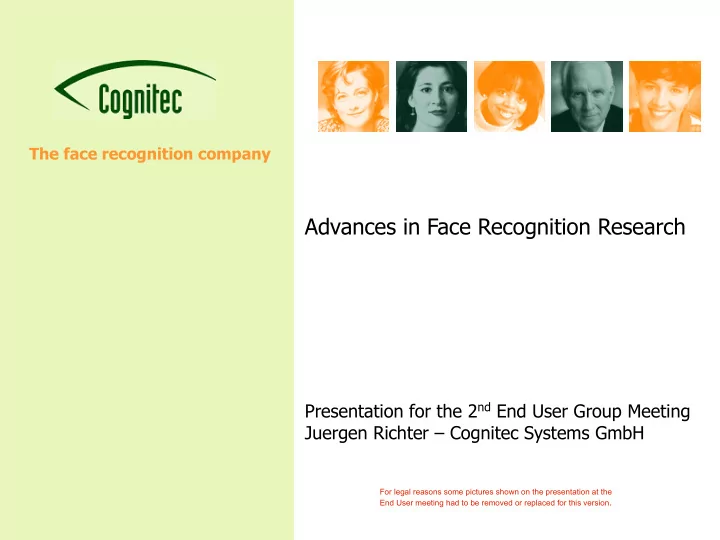

The face recognition company Advances in Face Recognition Research Presentation for the 2 nd End User Group Meeting Juergen Richter – Cognitec Systems GmbH For legal reasons some pictures shown on the presentation at the End User meeting had to be removed or replaced for this version .
Outline • How does Cognitec's 3D Face Recognition work ? • Resulting research tasks and achievements since start of the EU 3DFace project • Conclusions for development and user scenarios 2
Face Recognition: Principal Approach Input Data Data as provided by sensor Feature Extraction Features with reduced contingency Raw Features Classification Transformation Feature Vector Features transformed to optimally distinguish individualities 3
Characterization of Sensor Data • Typically contains more than just the face • Varying orientation in space (pose) • Occasional data corruption (gaps, outliers, artefacts like ripples) • Deformations of facial surface due to glasses, hairdo and beard 4
3D Face Recognition: Feature Extraction •Localize facial part of 3D shape •Align facial region to some defined orientation •Preprocess shape to eliminate data flaws (Smoothing) •Apply some feature extraction operator (Reduced dimension input for classification 5
3D Face Recognition: Localization • Very accurate 2D feature finders available • Task of feature localization much more difficult for 3D shapes => Use Power of 2D feature finders for 3D localization, too! 6
3D Face Recognition: Localization Starting from 2D locations, find 3D locations by pixel – vertex correspondence i = 1,2,... k= 1, 2, . . . 7
3D Face Recognition: Alignment 8
3D Face Recognition: Shape Preprocessing Eliminate data flaws related to: • Noise: deviations from true positions with some continuous random distribution • Outliers: isolated points or groups of points with large deviation from true positions • Gaps: locations where 3D data is missing at all • Occlusions: particular sort of gaps in regions not available to sensor measurement One algorithm fits all: 3D surface reconstruction by “Moving Least Squares” 9
Least Squares Method (1) Linear Regression: Find line linearly approximating a set of points => minimize sum of squared distances 10
Least Squares Method (2) Disadvantage: Sensitive to outliers! 11
3D Face Recognition: Moving Least Squares (MLS) Local Neighbourhood Tangential Plane MLS Surface Probe points Local Least Squares Approximation 12
3D Face Recognition: Processing Steps Sensor Data MLS smoothed Aligned 13
3D Face Recognition: Major Research Tasks • Improvement of 2D Feature Finders (face finder, eyes finder) • Implementation and optimization of MLS algorithm • Optimization of classification algorithm “Improvement” and “Optimization” both in terms of biometric performance, robustness and computing speed! 14
Selected Achievements: Face Finding Face Finder Performance: % of faces not/incorrectly found Face Database T6 (2006) T8 (2008) Mainly frontal images, low variation in lighting: Cferet-frontal 0.1 0.04 Internal 1 0.2 0.05 Internal 2 0.3 0.2 Strong variations in both pose and lighting: Weizmann 1.7 0.1 Internal 3 0.3 0.1 15
Selected Achievements: Recognition Performance 16
Selected Achievements: Computing Speed MLS Surface (200x200) Computation Timings (sec) on Xeon 3220 (QuadCore, 2.4 GHz) 1 Thread 4 Threads 1 st MLS version 20 n/a May 2006 MLS version in TDF Modules 6.8 1.8 Dec 2007 Most recent MLS version 0.9 0.4 Feb 2008 17
Avoidable Data Flaws • Nonfrontal pose resulting in data gaps • Occlusions caused by caps, dark glasses, strands of hair • Data artefacts (ripples, gaps, outliers) caused by head motion during capture 18
Conclusions For Sensor and Application Developers: • Keep exposure time low • Provide clear feedback on start and end of exposure phase • Reduce processing times as far as possible For user scenario: “Educate” cooperative user • Look straight into sensor camera • Keep neutral expression • For time of exposure, try to freeze head movements • Avoid occlusion of face (caps, dark sunglasses, hair) 19
Recommend
More recommend